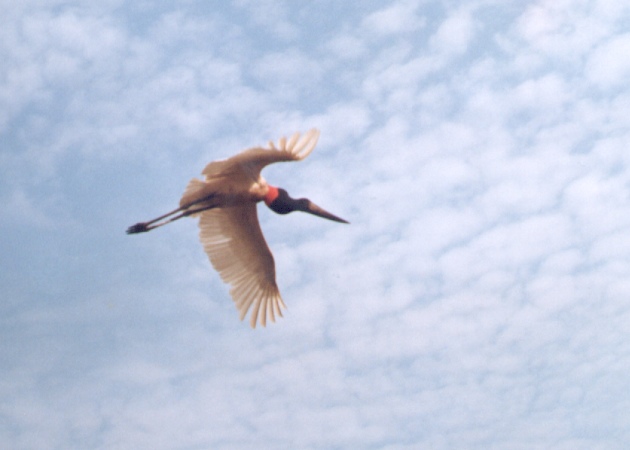- Jabiru
__NOTOC__:"This article is about the bird "Jabiru mycteria" from the Americas; for other uses, see
Jabiru (disambiguation) ."Taxobox
name = Jabiru
fossil_range = EarlyPliocene to Recent
status = LC | status_system = IUCN3.1

image_width = 250px
regnum =Animal ia
phylum = Chordata
classis = Aves
ordo =Ciconiiformes
familia =Ciconiidae
genus = "Jabiru "
genus_authority = Hellmayr, 1906
species = "J. mycteria"
binomial = "Jabiru mycteria"
binomial_authority = ( Lichtenstein, 1819)The Jabiru ("Jabiru mycteria") is a large
stork found in theAmericas fromMexico toArgentina , exceptwest of theAndes . It is most common in thePantanal region ofBrazil and theEastern Chaco region ofParaguay . It is the only member of thegenus "Jabiru". The name comes from the Tupi-Guaraní language and means "swollen neck".The name Jabiru has also been used for two other birds of a distinct genus: the
Asia nBlack-necked Stork ("Ephippiorhynchus asiaticus"), commonly called "Jabiru" inAustralia ; and sometimes also for theSaddle-billed Stork ("Ephippiorhynchus senegalensis") of sub-SaharanAfrica . In particular, Gardiner's Egyptian hieroglyph G29, believed to depict an "E. senegalensis", is sometimes labeled "Jabiru" in hieroglyph lists.In Portuguese, the bird is called "jabiru", "jaburu", "tuiuiu", "tuim-de-papo-vermelho" ("red-necked "tuim", in
Mato Grosso ) and "cauauá" (in theAmazon Basin ). The name "tuiuiu" is also used in southern Brazil for theWood Stork ("Mycteria americana").The proposed
Late Pleistocene fossil stork genus "Prociconia " from Brazil might actually belong into "Jabiru". A fossil species of jabiru was found in the earlyPliocene Codore Formation nearUrumaco ,Venezuela ; it has not yet been described (Walsh & Sánchez 2005).Description
The Jabiru is the tallest flying bird found in
South America andCentral America , often standing around the same height as the flightless and much heavierAmerican Rhea . The adult Jabiru is typically 122-140 cm (48-55 in), 230-280 cm (90-111 in) across the wings, and weigh to 8 kg (17.6 lbs). The larger males may stand as tall as 1.5 m (5 feet). The beak, up to 30 cm (1 ft) long, is black and broad, slightly upturned, ending in a sharp point. Theplumage is mostly white, but the head and upper neck are featherless and black, with a featherless red stretchable pouch at the base. The sexes are similar, although the female is usually smaller than the male. While it is an ungainly bird on the ground, the Jabiru is a powerful and graceful flier.Habits
The Jabiru lives in large groups near rivers and ponds, and eats prodigious quantities of
fish ,mollusk s, andamphibian s. It will occasionally eatreptile s and smallmammal s. It will even eat freshcarrion and dead fish, such as those that die during dry spells, and thus help maintain the quality of isolated bodies of water.The nest of twigs is built by both parents around August–September (in thesouthern hemisphere ) on tall trees, and enlarged at each succeeding season growing to several meters in diameter. Half a dozen nests may be built in close proximity, sometimes among nests ofheron s and other birds. The parents take turns incubating the clutch of 2 to 5 white eggs.References
* Database entry includes justification for why this species is of least concern
* Walsh, Stig A. & Sánchez, Rodolfo (2005): Long legged South American birds and the first avian fossils from Venezuela. Presentation at The Palaeontological Association 49th Annual Meeting. [http://downloads.palass.org/annual_meeting/2005/confabs2005.pdf PDF abstract]
External links
* [http://ibc.hbw.com/ibc/phtml/especie.phtml?idEspecie=357 Jabiru videos] on the Internet Bird Collection
* Mangoverde.com: [http://www.mangoverde.com/birdsound/picpages/pic22-16-1.html Jabiru "Jabiru mycteria"] . Retrieved 2006-DEC-06.
* Saúde Animal: [http://www.saudeanimal.com.br/jaburu.htm Jaburu ou tuiuiú: Espécie animal brasileiro ameaçado de extinção] [in Portuguese] . Retrieved 2006-DEC-06.
* [http://www.zooscene.co.uk/Jabiru.html]
* [http://www.bird-stamps.org/cspecies/2201600.htm Stamps] (for 9 countries) with RangeMap
* [http://vireo.acnatsci.org/search.html?Form=Search&SEARCHBY=Common&KEYWORDS=jabiru&showwhat=images&AGE=All&SEX=All&ACT=All&Search=Search&VIEW=All&ORIENTATION=All&RESULTS=24 Jabiru photo gallery] VIREO
* [http://borderland-tours.com/v2/images/stories/borderland/gallery_photos/argentina/jabiru.jpgPhoto-High Res] ; [http://borderland-tours.com/v2/content/view/55/77/ Article] borderland-tours
Wikimedia Foundation. 2010.
